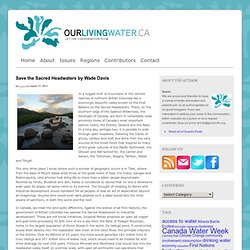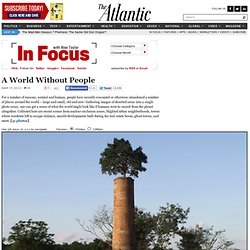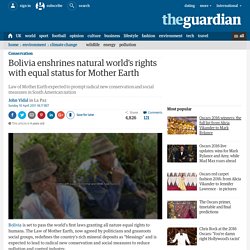

Save the Sacred Headwaters by Wade Davis. In a rugged knot of mountains in the remote reaches of northern British Columbia lies a stunningly beautiful valley known to the First Nations as the Sacred Headwaters.

There, on the southern edge of the Spatsizi Wilderness, the Serengeti of Canada, are born in remarkably close proximity three of Canada’s most important salmon rivers, the Stikine, Skeena and the Nass. In a long day, perhaps two, it is possible to walk through open meadows, following the tracks of grizzly, caribou and wolf, and drink from the very sources of the three rivers that inspired so many of the great cultures of the Pacific Northwest, the Gitxsan and Wet’sutwet’en, the Carrier and Sekani, the Tsimshian, Nisga’a, Tahltan, Haisla and Tlinglit. The only other place I know where such a wonder of geography occurs is in Tibet, where from the base of Mount Kailas arise three of the great rivers of Asia, the Indus, Ganges and Brahmaputra, vital arteries that bring life to more than a billion people downstream. PANTHEISM: the World Pantheist Movement.
Save the Sacred Headwaters by Wade Davis. A World Without People - In Focus. For a number of reasons, natural and human, people have recently evacuated or otherwise abandoned a number of places around the world -- large and small, old and new.

Gathering images of deserted areas into a single photo essay, one can get a sense of what the world might look like if humans were to vanish from the planet altogether. Collected here are recent scenes from nuclear-exclusion zones, blighted urban neighborhoods, towns where residents left to escape violence, unsold developments built during the real estate boom, ghost towns, and more. [41 photos] Use j/k keys or ←/→ to navigate Choose: A tree grows from the top of a chimney in an abandoned factory yard in Luque, on the outskirts of Asuncion, Paraguay, on October 2 , 2011. A bust of Confucius rests at an abandoned workshop in the town of Dangcheng in Quyang county, 240 km (150 miles) southwest of Beijing, on December 7, 2011. Ivy grows over a street in Tomioka town, Fukushima, northeastern Japan, on August 19, 2011. Facebook. Grossnationalhappiness. Bolivia enshrines natural world's rights with equal status for Mother Earth.
Bolivia is set to pass the world's first laws granting all nature equal rights to humans.

The Law of Mother Earth, now agreed by politicians and grassroots social groups, redefines the country's rich mineral deposits as "blessings" and is expected to lead to radical new conservation and social measures to reduce pollution and control industry. The country, which has been pilloried by the US and Britain in the UN climate talks for demanding steep carbon emission cuts, will establish 11 new rights for nature.
They include: the right to life and to exist; the right to continue vital cycles and processes free from human alteration; the right to pure water and clean air; the right to balance; the right not to be polluted; and the right to not have cellular structure modified or genetically altered. "It makes world history. Earth is the mother of all", said Vice-President Alvaro García Linera. But the abstract new laws are not expected to stop industry in its tracks. Helen Keller Nailed It In This Quote.